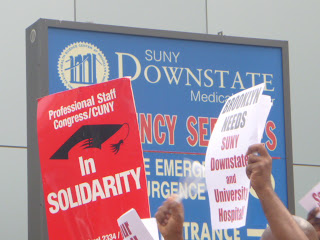 |
| Kings County Hospital Clarkson Street, Flatbush, Brooklyn Photo by Irving Underhill. |
Shortly after primary night, it became clear that the nominee
and presumptive nominee for mayor of New York were both from Brooklyn. An article
in the New York Times suggested this shift moves the center of gravity for
New York away from a Manhattan centric, pro – growth, entrepreneurial model,
toward a more expansive vision of New York and beyond. A Brooklyn perspective just might open us up
to a new way of looking at all of New York, as a city which expands from Jerome
Ave through East New York, rather than a subway ride from 79th
street to City Hall in Manhattan. This
is the New York of the peripheries, of long subway rides, bike rides over the
Manhattan Bridge, trips to the Beach, across the Throgs Neck.
“When I was a child I
thought we lived at the end of the world,” explains Alfred Zazan in his 1951
book, Walker in the City. “It was the
eternity of the subway ride into the city that first gave me this idea.” This space which was almost all the
periphery. Like Los Angeles, it seemed
to go on forever, especially on a long subway ride. Kazin traces us through his ride from the
East River, beneath the Brooklyn Bridge, past Borough Hall and Prospect Park
out to Canarsie. “We were of the city
but somehow not in it,” he confesses.
“We were at the end of the line.
We were the children of immigrants who had cramped at the city’s back
door, in New York’s rawest, remotest, cheapest ghetto, enclosed on one side by
the Canarsie flats and on the other side by the hallowed middle class districts
that showed the way to New York”.
Yet, could a new mayor who knows this ride into the
periphery of our city, better understand the plight of those residing
there? Could this make a difference? Does it matter? After all, all mayoral candidates in New York
are captive to a pro growth urban regime, notes
William Sites.
After election night in 1965, Mayor John Lindsay woke
from huge accolades, to a series of municipal strikes and actions. Somehow 2013 feels similar
to that moment.
Thursday, I rode my bike across the Brooklyn, past Barklays,
toward Grand Army Plaza, past the Brooklyn Museum, down Eastern Parkway bike
path to attend a rally to Save SUNY Downstate and University Hospital on
Clarkson Ave.
Members of my union, the Professional Staff Congress, were
there in solidarity.
I spoke with Mike Fabricant, my old prof from Hunter, about
the politics of hospital closings.
“Good neighborhoods need schools and hospitals and
transportation,” he chimed in.
 |
| Signs for condos where St Vincent's once stood. |
The new mayor will have to put together a plan to move
expired union contracts and to save the hospitals, while actually framing HIV
prevention and homelessness around health, not punishment. Certainly, de Blasio drew everyone’s
attention when he stood up for Long Island College Hospital. The way he responds to these choices will
tell us a lot. Hopefully he will choose
policy options which offer a route toward a city with less inequality, a space
which feels like the gap between the one percent and the 99 is shrinking rather
than expanding.
A dozen years ago few of us had heard of Bloomberg. Yet, he became mayor by out spending a
competent public advocate. And so can
Lhota.
Later after the rally, I ran into the grocery store,
stumbling into Martin
Amis, who has recently moved to Brooklyn. My daughter begged me not to go
chat about the time I saw him read in San Francisco. Still, I was glad to see him there. This is the Brooklyn with many, many
stories.
That night at the
pub, an ambulance from Long Island College Hospital arrived outside. It was great to see LICH in action, not
boarded up and turned into condos.
Activism saved this space, which had been destined to be closed
down. Hopefully, it saves all the
hospitals in New York.
Hopefully, the new mayor is open to more and more of the New
York stories out there. This naked city
really is a space of stories. It is a
space of highs and lows, art and graffiti, climate crisis, car crashes,
homelessness, and a continuing HIV crisis.
These stories come from the streets of the periphery.
Hopefully, the new
mayor is open to engaging a few more of these stories than the highbrow
narrative of the Bloomberg years.












No comments:
Post a Comment